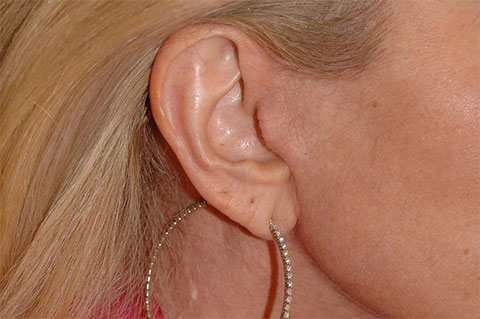New York Center for Facial Plastic Surgery
Schedule a consultation

Information About Facial Scars Following a Facelift Procedure in New York with Dr. Andrew Jacono.
One of the most popular surgical techniques used to address the signs of facial aging is a facelift. Dr. Jacono performs this procedure to restore the lost volume to the midface (cheeks). It also corrects the jowls (fat build-up between the cheeks and chin). And the reduction of deep folds and wrinkles to improve the contour of the neck.
Facelift Scarring This female facelift patient dicsusses her surgical concerns and her experience with Dr. Jacono. Listen to her explain how happy she was that there was no visible scarring.
The results of this procedure can restore a youthful appearance leaving patients looking 10 years younger. What is also to be noted, is that a facelift is a surgical procedure. Incisions will be made, some scarring may be present.
Will I have visible scarring after facial plastic surgery? This is one of the most frequent questions that facelift patients regularly ask Dr. Jacono. Expect scarring in cosmetic surgery, except in non-invasive options. Surgical procedures by an experienced facial plastic surgeon like Dr. Jacono minimize scarring.
Facelift scars behind the ears, and face and neck lift scars, should be undetectable when fully healed. Dr. Jacono specializes in concealing scars effectively as he is a dual board-certified facial plastic surgeon. He is a dual board-certified facial plastic surgeon who excels at concealing facelift scars, going beyond ear stitches and hairline scars.
Dr. Jacono, a facelift pioneer, lectured at prestigious institutions like Harvard, Yale, Stanford, and the University of Pennsylvania.
He’s delivered 100+ facelift lectures at national and international plastic surgery symposia, mentoring surgeons worldwide in incision placement artistry.
New York Center for Facial Plastic Surgery
Schedule a consultation




Where the facelift incisions are placed is important to a successful outcome. Not only for the results of the facelift procedure but also for hiding the scar. Facelift surgery typically involves incisions behind the ear, regardless of the specific type of facelift procedure being performed.
The most visible scars for men and women occur when the incision is placed directly in front of the ear. Dr. Jacono has developed a technique that allows the scar to be less visible. Hiding the incision inside the tragus cartilage of the ear canal and behind the ear. By doing this, Dr. Jacono eliminates an unsightly scar leaving natural-looking results and reducing signs of aging.
Dr. Jacono is able to hide lower facelift scars and mini facelift scars.
Dr. Jacono performed a minimal access deep plane facelift, platysmaplasty, temporal lift, and importantly a lip lift. The deep plane technique lifts the jowls and dropped cheeks, lifting them up and restoring the natural apple cheeks of youth. As you can see pictured below, her hair is pulled back and there are no visible scars from the facelift surgery!


Prior to your surgery patients should learn as much about the facelift procedure as they can. During your consultation with Dr. Jacono, he will explain the procedure in detail and any questions that you have will be answered. Pre-operative and post-operative instructions will be given to each patient and it is important they follow those instructions. Keeping the incision area clean is extremely important and after about two weeks of recovery, patients should gently massage the incision to help with the healing process.
Schedule your consultation with Dr. Jacono today. You can also call 516-773-4646 to schedule your appointment.

Dr. Jacono was selected as one of the Top Ten Facial Plastic Surgeons in New York (2012-2023)

Dr. Jacono has been a Castle Connolly Top Doctor (2012-2023)

Andrew Jacono, MD, FACS has been honored with the Patient’s Choice Award (2012-2023)

Accessibility: If you are vision-impaired or have some other impairment covered by the Americans with Disabilities Act or a similar law, and you wish to discuss potential accommodations related to using this website, please contact our Accessibility Manager at (212) 570-2500 .